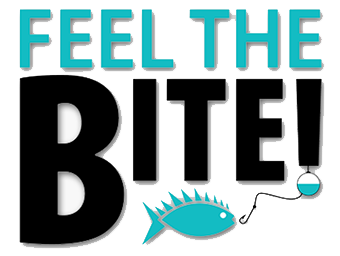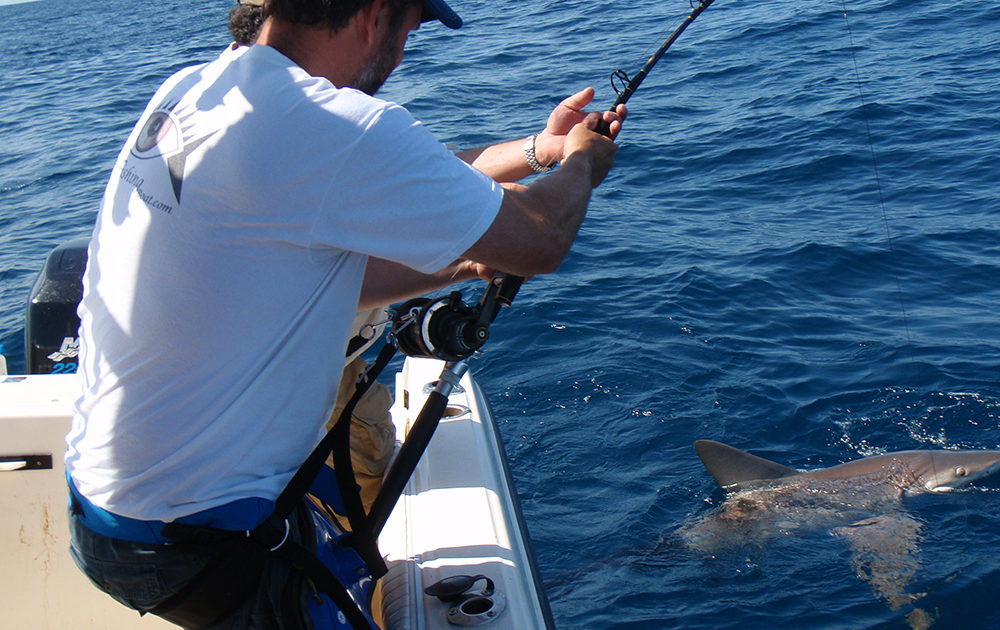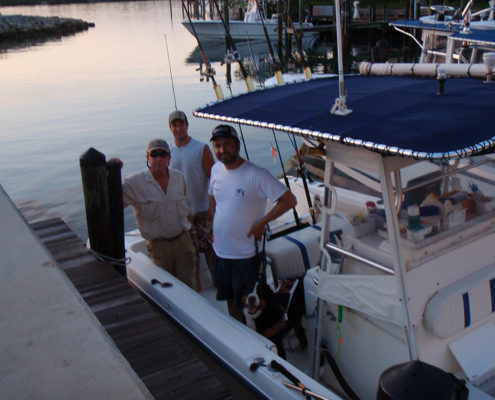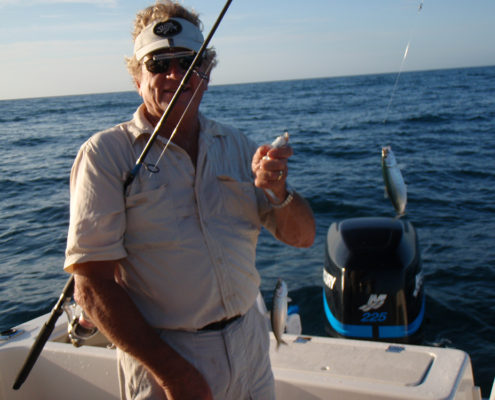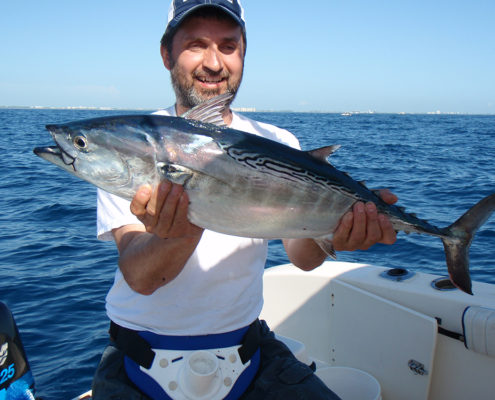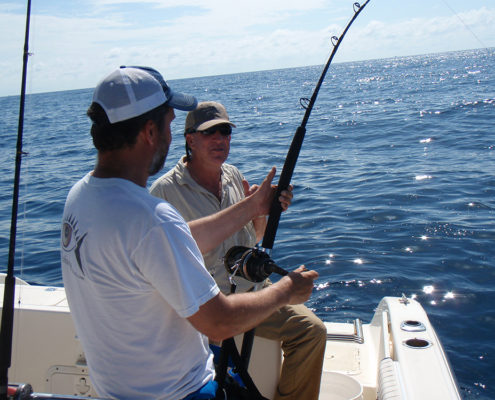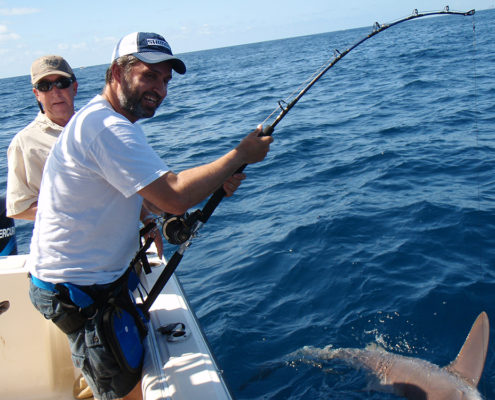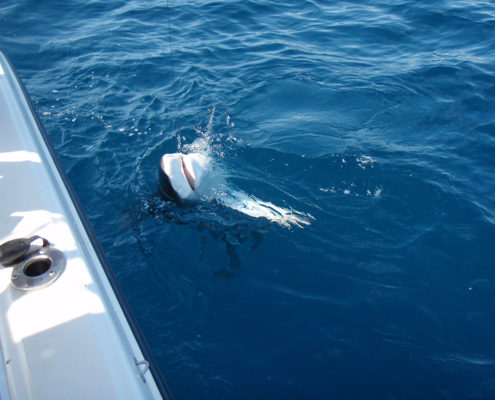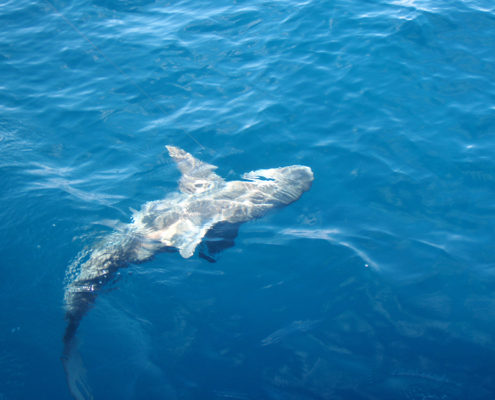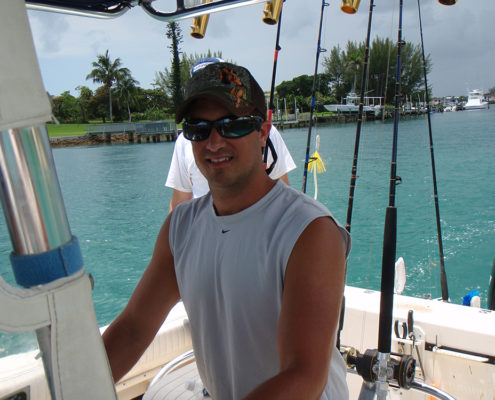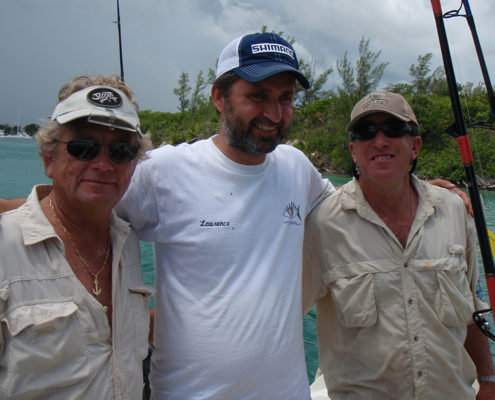White-Tip Shark in Jupiter
Following a hectic four days at the No Barriers USA Festival in Miami, Lance Glaser of Goldon Fishing Expeditions invited me to spend a day with him and several of his friends fishing the Near Shore just off Jupiter Island. I was told that the fishing promised to be excellent as a number of different species were in the midst of schooling up to spawn. Well, excellent turned out to be an understatement.
We left the marina at Jupiter at around 6: a.m. aboard a 26-foot Sea Fox skippered by Jon Capinelli. Lance, Roy and myself made up the rest of the crew, and Maestro came along to observe the action as usual.
After motoring out of the inter-coastal waterway just south of Jupiter Island we stopped over top of a sunken barge to load up on some bait. The Smelt were thick below the boat causing the sonar to give a false bottom reading of 8 feet. Using light spinning gear equipped with six-hook rigs, it wasn’t long before the live wells were teaming with 6-8 inch Smelt. Our only problem was keeping the monster Bone Fish circling our boat from attacking the Smelt on the lines as we reeled them up to the boat – more than one line was cut. Many other game fish were occupied with feeding off the school, but Jon had another location in mind for us where more variety of game fish could be found.
We motored for another 45 minutes through seas that ranged between 4 and six feet that made progress slower than we would have liked. After observing a number of commercial and charter boats in the area where we planned to fish, we knew we were in the right place. Within minutes of stopping the action commenced.
The Smelt were nose hooked with treble hooks on 30lb mono line. Pitched over the side, the Smelt were able to easily pull line off the free spool as they swam for cover. Occasionally a Smelt would head down only to change directions after 20 or so feet due to the numerous game fish that were circling about 30 feet below the boat. However, they never stood a chance of escaping, and one could feel their panic through the line as large game fish made chase.
Once a game fish captured the Smelt on your line, the idea was to give it a few moments to swim away with the bait so that it might properly place the Smelt in their mouths. One then took the reel off free-spool, waited for the pressure to put a good curve in the rod, and set the hook.
While I focused my attention on fishing Smelt for mostly Bonita, Lance and Roy experimented with surface lures and jigs. The Bonita weighed in at between 10 and 20 pounds, and were more than capable of giving a good fight, being that they are part of the Tuna family.
After a couple hours of fishing, I began to notice that the Bonita were beginning to act differently once hooked. Instead of diving and performing large figure eight patterns below the boat, every second or so fish would execute two or more line-screaming runs more than just the initial run I had grown use to. These runs were often followed up by my experiencing line separation. I asked Lance what was going on, and he suggested that maybe it was time to get me into the stand-up fighting harness.
The stand-up harness allows a fisher to use their leg and back muscles to fight large fish. No chair is used, and the fisher doesn’t need to use a lot of arm strength. Lance figured that sharks had now joined our party and were taking advantage of the hooked fish around the boat for easy meals.
I caught another 15lb Bonita which Lance then rigged on a special single hook harness using 600lb steel leader on a rod equipped with a two-speed reel loaded with 200lb braid line.
We dropped the Bonita over the side of the boat and lowered it to a depth of about 30 feet. It wasn’t five minutes before significant chomping could be felt through the line. We gave it a few minutes to hook up, but the first time the shark took the bait it only lasted about a minute before the bait came free. It obviously had grabbed a portion of the Bonita that was hook free. Several seconds later it, or another shark, grabbed the bait and began swimming off. We left it for a minute to hook up, and then set the hook.
Using your body to fight a large fish is quite an experience. A lot depends on balance. If you let yourself lean forward to far, recovering your balance is almost impossible. I learned this the hard way having almost gone over-board and would have had not Lance pushed me back on to my heels.
Through steadily and repeatedly squatting I was able to raise the rod tip, then lower it by standing giving me the chance to take in line. The Shark made several decent runs, but the drag on the reel was cranked down to about 80lbs, which didn’t give the fish much of a chance.
The key is to never give the fish a chance to run and re-oxygenate itself. By continually turning the fish’s head back towards the boat, you accomplish two things. One, the fish loses hope of escaping, and two, its muscles suffer from lactic shock resulting from the lack of oxygen required to clear the Lactic acid from their muscles. The key is to never stop pumping the rod and taking in line.
Within 15 minutes I had a 300lb White Tip Shark, or also known as a Bull Head Shark, up along side the boat. After taking a few photos and giving the fish a chance to recover from the struggle, Jon snipped the wire leader close up to the Sharks mouth, and the shark swam free.
Fish recover quickly from lactic shock, which means they are less likely to fall prey to other predators in the sea. An exhausted fish that experienced a number of long runs means it is unable to recover significantly for a considerable period of time.
Not long after we released the Shark, the sky began clouding over so we headed in-shore to see about catching some dinner. Using chunks of Bonita on two-hook rigs with 2-ounce sinkers, we were able to haul in a number of nice eating Yellow Tail.
Upon our return to the marina, we were met by an over-sized fork lift which placed our boat on a temporary crib so we could wash down and flush vital components of the boat.
A big thanks to Jon, Lance and Roy for the wonderful day. Lance is an expert fisher and experienced adaptive fishing coach. He organizes adaptive adventures throughout the world and has a network of accessible facilities that offer pretty near every type of fishing imaginable. Lance is also a Bass Classic winner and holds a number of world records, many of which were caught on a fly. Lance Glaser can be reached directly at tell: 970-470-2871, or by email at: lggoldon@msn.com.
